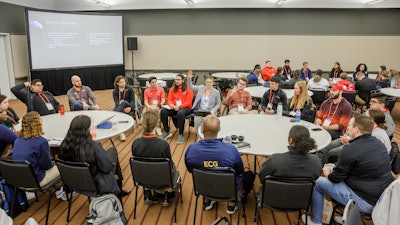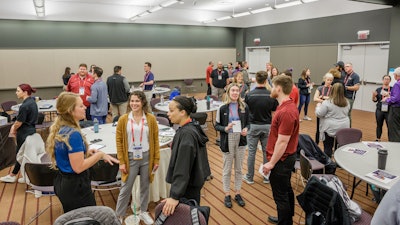
Four years after COVID-19 upended campus recreation, the profession is adjusting to new realities that emerged in the pandemic’s wake.
“What people are talking about since we returned from the pandemic has shifted,” says Erin Patchett, incoming NIRSA president and director of administration and assessment for campus recreation at Colorado State University. “COVID is still here, but now the conversations are about what can be learned and what can be changed to better serve students and staff.”
NIRSA’s latest “Industry Insights” report — which, in collaboration with Association Laboratory Inc., tracks demographics and work environment — is likely to spark even more conversations. The new report highlights the following three realities about the state of campus recreation in 2024 and suggests potential next steps:
1. The workforce pipeline is changing.
2. Campus recreation plays a key role in wellbeing.
3. The wellbeing of the workforce needs attention.
“Everything in this report resonates with me, because these conversations are happening across campuses and all NIRSA spaces,” Patchett says.
The benchmarking report, the fourth one NIRSA has issued since 2017 and based on data collected last September, is expected to be available to members electronically in time for the NIRSA Annual Conference and Campus Rec & Wellness Expo, April 17-20 in Phoenix. This year’s theme is “Centering Belonging and Cultivating Community,” and several educational sessions and activities will focus on the report’s themes.
“I’m excited that a lot of the topics we’re covering at the conference are congruent with what’s in this report,” says NIRSA Conference chair Rachael “Roach” Finley, who until recently was campus recreation director at York College of Pennsylvania and now runs her own consulting and coaching practice. “It’s unfortunate that these are some of the issues, but the content and opportunities that will be at the conference are top-notch and will address them.”

Three takeaways
While the “Industry Insights” report raises several issues, one of the most urgent involves the changing educational background of the incoming campus recreation workforce. According to the report, 55 percent of student respondents in 2023 are pursuing a graduate degree, down from 67 percent in 2020. This potential decline in students seeking graduate degrees may change the employee pipeline, leading to fewer people with master’s degrees and the work experience typically gained from graduate assistantships.
“This development asks us to change how we write job descriptions and how we onboard new staff who are coming to us with a bachelor’s degree instead of a GA and a graduate degree,” Patchett says.
The workforce pipeline is shrinking, too, according to the report. The number of members in the early-career stage dropped from 28 percent in 2017 to 18 percent in 2023 — a development that could put even more stress on existing campus recreation staff members who might already be overworked or experiencing burnout.
“We need to be strategizing on our own campuses, but we also need to be strategizing as an industry about how we’re going to adapt,” Patchett says. “We need to make changes and bring people back, or adjust the pipeline, because this is a great job. To work on a college campus and have the opportunity to support students gives us so much joy and energy. If we can start to take care of some of the concerns around pay or burnout, it will be much easier for us to continue to encourage people to come into this field.”
Which leads to another takeaway from the “Industry Insights” report. Recruiting and retaining staff, maintaining and replacing aging infrastructure, a prevalence of mental health issues, and staff burnout are among the biggest obstacles facing campus recreation professionals.
To overcome them, the report suggests creating a culture that normalizes a 40-hour work week, supports flexible and hybrid work arrangements, and reconciles programs and services with the realities of current staffing levels.
The report also acknowledges that campus recreation has evolved beyond the physical aspect of health and wellness, and that the majority of professionals in the fields are striving to improve students’ sense of belonging, provide a safe and inclusive environment for students, and improve student wellness. These goals are particularly pressing, considering the prevalence of mental health issues among students, according to the report. The good news, Patchett says, is that today’s students are more willing to talk about mental health — and seek assistance — than previous generations.
That said, increasing the ways in which students can participate in recreation could encourage a greater sense of belonging. For example, the report suggests developing recreation leagues to serve student-connectedness needs, creating open leagues to ensure inclusion around gender identity instead of centering on policies and rules, and offering self-officiating leagues to focus participation on the social aspect of the game (while also saving money and reducing staff workload in an effort to address other issues noted in the report).
“Student wellbeing matters, and we need to keep focusing on that,” Patchett says. “But this report serves as a reminder that we need to continue as a profession to elevate our own wellbeing literacy.”
Reasons for optimism
That’s where this year’s NIRSA Conference comes in. Not only will many presentations focus on core takeaways from the “Industry Insights” report, but the overall vibe also will intend to help attendees embrace the idea of belonging — from longer breaks between educational sessions to the messages delivered by mainstage speakers.
“For those of us who’ve been in the field for a long time, the NIRSA Conference is a family reunion, and it’s really easy to throw our arms around our friends we haven’t seen since the last conference and forget to open our arms to people we don’t know,” Finley says. “Last year, 40 percent of our conference attendees were brand new, and what we unintentionally did was make those new people not really feel all that welcome, because we didn’t cultivate a sense of belonging.”
It’s worth noting that this year’s conference location, Phoenix, also was the intended location of the COVID-canceled 2020 NIRSA Conference. And that has Finley feeling optimistic.
“This is the year that could feel the most like pre-COVID times, compared to the last three conferences,” she says. “We can embrace being together, which was stripped from us in 2020. Plus, we will engage with our new post-Great Resignation professionals, and our attendance numbers keep increasing. One of the things that makes the NIRSA Conference so special is the energy that comes from the people there. Pre-COVID, we were pushing 3,000 attendees. So, I’m hoping we’ll be back up to about 2,000. There’s a lot of good energy right now.”
Both Finley and Patchett hope that good energy keeps flowing long after the conference is over — flourishing on individual campuses and leading to the kind of changes highlighted in the “Industry Insights” report.
“I think it is a little harder to work in our field right now,” Patchett admits. “And while it is more challenging, all I can see are the opportunities for us to shift in ways that are going to transform the way we operate — both for us as professionals and for the students receiving our services.”





































